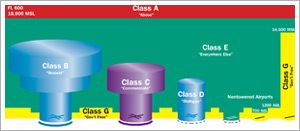 Most pilots spend most of their flying time operating in controlled airspace. But for the different classes of controlled airspace, there are varying degrees of control. The largest swath of controlled airspace isn't controlled beyond your obligation to observe weather requirements for VFR flight within its boundaries.
Most pilots spend most of their flying time operating in controlled airspace. But for the different classes of controlled airspace, there are varying degrees of control. The largest swath of controlled airspace isn't controlled beyond your obligation to observe weather requirements for VFR flight within its boundaries.
The basic differences can be summed up in the term "positive control." As defined in the Pilot/Controller Glossary of the Aeronautical Information Manual, positive control "means control of all air traffic, within designated airspace, by air traffic control."
Class A airspace, starting at 18,000 feet, is an example. Entry requires a clearance under instrument flight rules from ATC. Before airspace was classified by letters, Class A airspace was known as the positive control area. Pilots operate under positive control in Class B airspace, surrounding the busiest airports. You may not enter Class B airspace without a specific clearance from ATC. "Class B airspace provides for positive control of both VFR and IFR traffic.
Class C airspace, surface-based and centered on a towered airport with radar service, requires that communications be established, but specific clearance into the airspace is not required. In Class D airspace, centered on an airport with an operating control tower, there is also a requirement to establish two-way communications. The airspace reverts to Class E when the tower is not operating [Class G if weather information is not available].
In the vast reaches of Class E airspace a pilot may fly with no ATC interaction—provided the appropriate weather requirements for VFR flight are satisfied. However, it is recommended that pilots make use of radar flight following when and where it is available. And nowadays it is prudent to check notams for temporary flight restrictions along any route.
Positive control can require different procedures for different kinds of flights in airspace such as the Washington Air Defense Identification Zone (ADIZ).
No comments:
Post a Comment